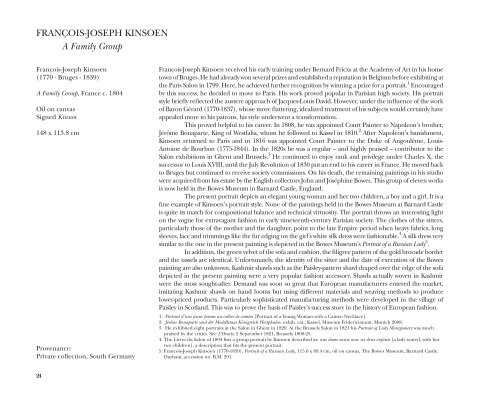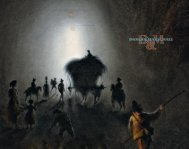Catalogue 2010 - daxer & marschall
Catalogue 2010 - daxer & marschall
Catalogue 2010 - daxer & marschall
You also want an ePaper? Increase the reach of your titles
YUMPU automatically turns print PDFs into web optimized ePapers that Google loves.
FRANçOIS-JOSEPH KINSOEN<br />
A Family Group<br />
François-Joseph Kinsoen<br />
(1770 - Bruges - 1839)<br />
A Family Group, France c. 1804<br />
Oil on canvas<br />
Signed Kinson<br />
148 x 113.8 cm<br />
Provenance:<br />
Private collection, South Germany<br />
24<br />
François-Joseph Kinsoen received his early training under Bernard Fricxs at the Academy of Art in his home<br />
town of Bruges. He had already won several prizes and established a reputation in Belgium before exhibiting at<br />
the Paris Salon in 1799. Here, he achieved further recognition by winning a prize for a portrait. 1 Encouraged<br />
by this success, he decided to move to Paris. His work proved popular in Parisian high society. His portrait<br />
style briefly reflected the austere approach of Jacques-Louis David. However, under the influence of the work<br />
of Baron Gérard (1770-1837), whose more flattering, idealized treatment of his subjects would certainly have<br />
appealed more to his patrons, his style underwent a transformation.<br />
This proved helpful to his career. In 1808, he was appointed Court Painter to Napoleon’s brother,<br />
Jérôme Bonaparte, King of Westfalia, whom he followed to Kassel in 1810. 2 After Napoleon’s banishment,<br />
Kinsoen returned to Paris and in 1816 was appointed Court Painter to the Duke of Angoulême, Louis-<br />
Antoine de Bourbon (1775-1844). In the 1820s he was a regular – and highly praised – contributor to the<br />
Salon exhibitions in Ghent and Brussels. 3 He continued to enjoy rank and privilege under Charles X, the<br />
successor to Louis XVIII, until the July Revolution of 1830 put an end to his career in France. He moved back<br />
to Bruges but continued to receive society commissions. On his death, the remaining paintings in his studio<br />
were acquired from his estate by the English collectors John and Joséphine Bowes. This group of eleven works<br />
is now held in the Bowes Museum in Barnard Castle, England.<br />
The present portrait depicts an elegant young woman and her two children, a boy and a girl. It is a<br />
fine example of Kinsoen’s portrait style. None of the paintings held in the Bowes Museum at Barnard Castle<br />
is quite its match for compositional balance and technical virtuosity. The portrait throws an interesting light<br />
on the vogue for extravagant fashion in early nineteenth-century Parisian society. The clothes of the sitters,<br />
particularly those of the mother and the daughter, point to the late Empire period when heavy fabrics, long<br />
sleeves, lace and trimmings like the fur edging on the girl’s white silk dress were fashionable. 4 A silk dress very<br />
similar to the one in the present painting is depicted in the Bowes Museum’s Portrait of a Russian Lady 5 .<br />
In addition, the green velvet of the sofa and cushion, the filigree pattern of the gold brocade border<br />
and the tassels are identical. unfortunately, the identity of the sitter and the date of execution of the Bowes<br />
painting are also unknown. Kashmir shawls such as the Paisley-pattern shawl draped over the edge of the sofa<br />
depicted in the present painting were a very popular fashion accessory. Shawls actually woven in Kashmir<br />
were the most sought-after. Demand was soon so great that European manufacturers entered the market,<br />
imitating Kashmir shawls on hand looms but using different materials and weaving methods to produce<br />
lower-priced products. Particularly sophisticated manufacturing methods were developed in the village of<br />
Paisley in Scotland. This was to prove the basis of Paisley’s success story in the history of European fashion.<br />
1. Portrait d’une jeune femme au collier de camées [Portrait of a Young Woman with a Cameo Necklace].<br />
2. Jérôme Bonaparte und der Modellstaat Königreich Westphalen, exhib. cat., Kassel, Museum Fridericianum, Munich 2008.<br />
3. He exhibited eight portraits at the Salon in Ghent in 1820. At the Brussels Salon in 1821 his Portrait of Lady Montgomery was much<br />
praised by the critics. See L’Oracle, 2 September 1821, Brussels 1800-25.<br />
4. The Livret du Salon of 1804 lists a group portrait by Kinsoen described as: une dame assise avec ses deux enfants [a lady seated, with her<br />
two children], a description that fits the present portrait.<br />
5. Francois-Joseph Kinsoen (1770-1839), Portrait of a Russian Lady, 115.6 x 89.4 cm, oil on canvas, The Bowes Museum, Barnard Castle,<br />
Durham, accession no. B.M. 291.






